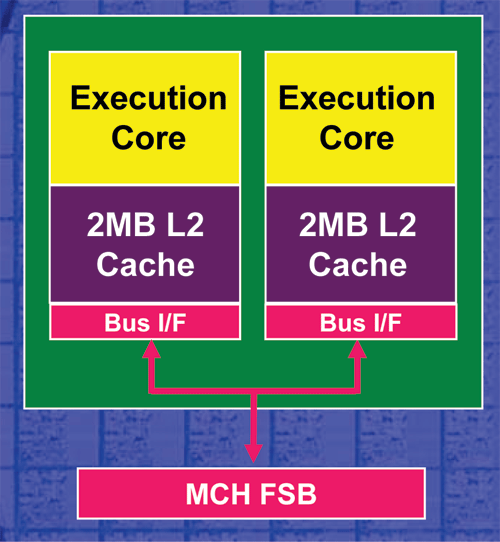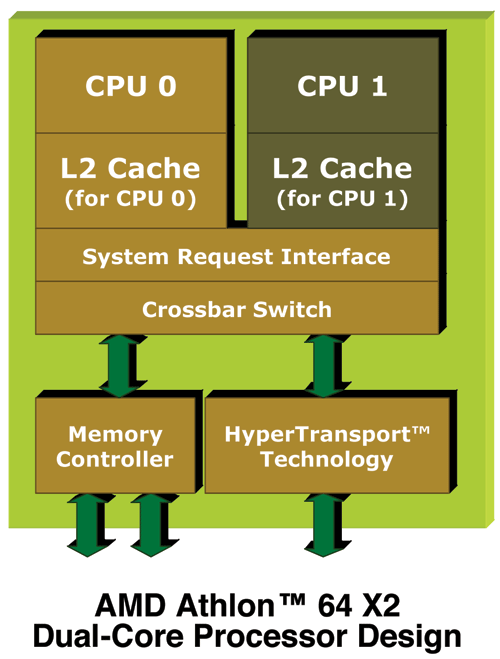AMD's dual core Opteron & Athlon 64 X2 - Server/Desktop Performance Preview
by Anand Lal Shimpi, Jason Clark & Ross Whitehead on April 21, 2005 9:25 AM EST- Posted in
- CPUs
A Look at AMD's Dual Core Architecture
Even Intel will admit that the architecture of the Pentium D is not the most desirable as is two Pentium 4 cores literally glued together. The two cores can barely be managed independently from a power consumption standpoint (they still share the same voltage and must run in the same power state) and all communication between cores must go over the external FSB. The diagram below should illustrate the latter point pretty well:
Intel's Pentium D dual core architecture
AMD's architecture is much more sophisticated, thanks to the K8 architecture's on-die North Bridge. While we normally only discuss the benefits of the K8's on-die memory controller, the on-die North Bridge is extremely important for dual core. Instead of having all communication between the cores go over an external FSB, each core will put its request on the System Request Queue (SRQ) and when resources are available, the request will be sent to the appropriate execution core - all without leaving the confines of the CPU's die. There are numerous benefits to AMD's implementation, and in heavily multithreaded/multitasking scenarios, it is possible for AMD to have a performance advantage over Intel just because of this implementation detail alone.

AMD's solution to the problem will come in the form of DDR2 and a new socket down the road, but for now there's no getting around the memory bandwidth limitations. Intel is actually in a better position from a memory bandwidth standpoint. At this point, their chipsets provide more memory bandwidth than what a single core needs with their dual channel DDR2-667 controller. The problem is that the Intel dual core CPUs still run on a 64-bit wide 800MHz FSB, which makes Intel's problem more of a FSB bandwidth limitation than a memory bandwidth limitation.
Backwards Compatibility
Intel's dual core Pentium D and Extreme Edition won't work in any previous motherboards, but as we mentioned at the start of this article, AMD has more bang. Here, the additional bang comes from the almost 100% backwards compatibility with single-core motherboards. We say "almost" because it's not totally perfect; here's the breakdown:- On the desktop, the Athlon 64 X2 series is fully compatible with all Socket-939 motherboards. All you need is a BIOS update and you're good to go.For desktop users, the ability to upgrade your current Socket-939 motherboards to support dual core in the future is a huge offer from AMD. While it may not please motherboard manufacturers to lengthen upgrade cycles like this, we have never seen a CPU manufacturer take care of their users like this before. Even during the Socket-A days when you didn't have to upgrade your motherboard, most users still did because of better chipsets. AMD's architectural decisions have made those days obsolete. The next generation of dual core processors will most likely need a new motherboard, but rest assured that you have a solid upgrade path if you have recently invested in a new Socket-939 desktop system or Socket-940.
- For workstations/servers, if you have a motherboard that supports the 90nm Opterons, then all you need is a BIOS update for dual core Opteron support. If the motherboard does not support 90nm Opterons then you are, unfortunately, out of luck.










144 Comments
View All Comments
Jep4444 - Thursday, April 21, 2005 - link
I don't like how you use the Opteron to give a rough estimation on the A64 X2 as their are other architectural changes between Opteron and A64That aside maybe AMD could bring out X2s using 256KB of cache per core to get slightly lower price points and atleast compete with the 830(3ghz)
I doubt it'll be too bandwidth limited given AMD is selling Semprons with only 128KB of L2 cache
KillerBob - Thursday, April 21, 2005 - link
It is usual to see that Anandtech favors the AMD, looks at the artificial tests, and not the real-world tests, where Intel wins out (as usual).In other tests itis pointed out the the PEE can be overclocked past 4GHz, in which case it'll kick everything's ass.
KillerBob - Thursday, April 21, 2005 - link
dannybin1742 - Thursday, April 21, 2005 - link
drool, i want oneDoormat - Thursday, April 21, 2005 - link
Typo P13: Intel's "975x" at bottom of page.The high price of the dual core opterons kinda puts me off. I was hoping for 2x the price of the single core, instead of 3.5x (I'm looking at 246 vs 270s). It looks like I'll be going single core (or just holding off) instead of dual core (at least until the end of the year and AMD gets price competition from Intel on the server DC front).
The 3.5x doesn't even make sense from the yield standpoint. If AMD's yeilds are 70% (wild talking-out-of-my-ass guess, no real factual grounding in picking that number), then their dual core yields will only be 49% (70% for the first core, 70% for the second core). So out of a batch of 1000 chips, instead of 700 you only get 490. Thats 210 chips you need to make up for. If opterons have a Avg selling price of $500, then the "adjusted" selling price would be around $715, an increase of 43%, not 250%. Granted, if AMD's yields are higher, the numbers look better (from our perspective - lower prices), but if their yields are less, it looks really bad (if their yield was only 50%, they'd only get 25% yield on dual core, and would have to double price).
I guess AMD is just trying to squeeze every dime they can out of this... hopefully that extra money goes to pay for Fab36 and more capacity.
cbuchach - Thursday, April 21, 2005 - link
Wow....Very impressive offering from AMD. I think the quote that sums it up best for me is: "you no longer have to make a performance decision between great overall performance or great media encoding performance, AMD delivers both with the Athlon 64 X2."I was very impressed with Intel dual core chips, but now I know that my next system will go back to be AMD-based. Overall the dual core Athlon64 should be killer.
As for cost, yes it is expensive, but the performance is really phenomenal. I am sure that it too will come down.
Griswold - Thursday, April 21, 2005 - link
All hail teh X2!bob661 - Thursday, April 21, 2005 - link
All I can say is.....WHOODOGGIE!!!!Brian23 - Thursday, April 21, 2005 - link
ME WANTY!!!jamawass - Thursday, April 21, 2005 - link
quote: Despite AMD's lead in getting dual core server/workstation CPUs out to market, Intel has very little reason to worry from a market penetration standpoint. We've seen that even with a multi-year performance advantage, it is very tough for AMD to steal any significant business away from Intel, and we expect that the same will continue to be the case with the dual core Opteron. It's unfortunate for AMD that all of their hard work will amount to very little compared to what Intel is able to ship, but that has always been reality when it comes to the AMD/Intel competition."This statement should be qualified. The Rendering market is much more adventurous than the standard server market(didn't they use winxp-64 beta running on opterons to render SWIII?) and will continue to rapidly adopt opterons.There're tangible benefits (faster rendering, lower energy costs=$$$) in moving to opteron for rendering farms. Also more oems like supermicro and broadcom have embraced AMD which should result in much more rapid market penetration than 2 yrs ago.